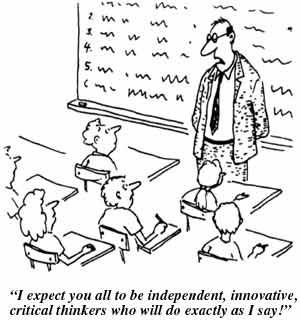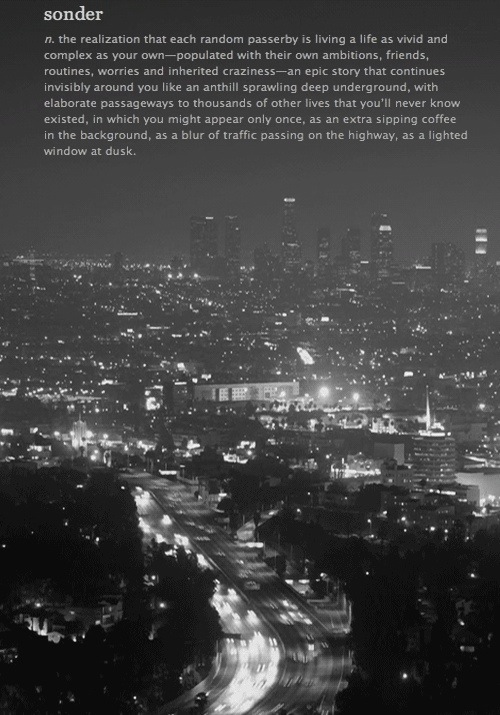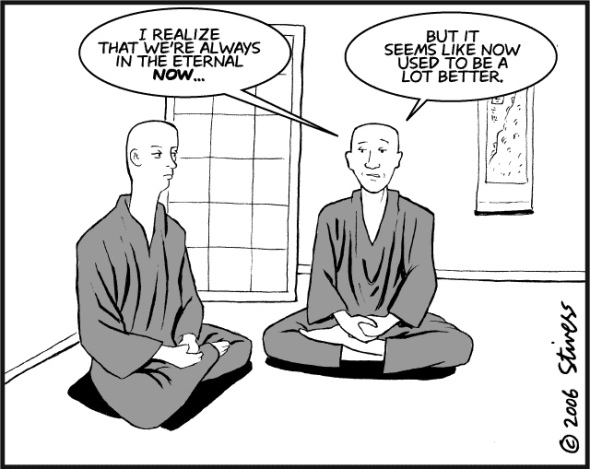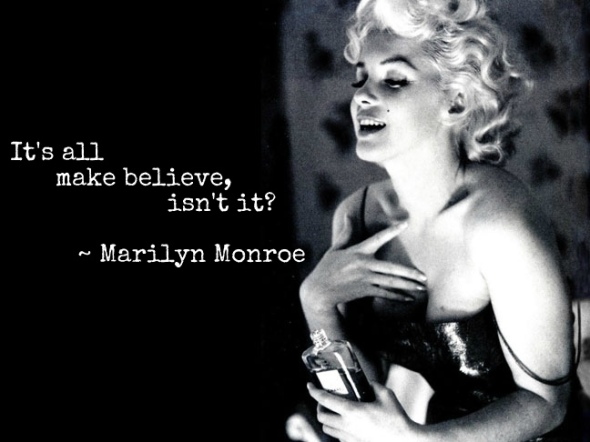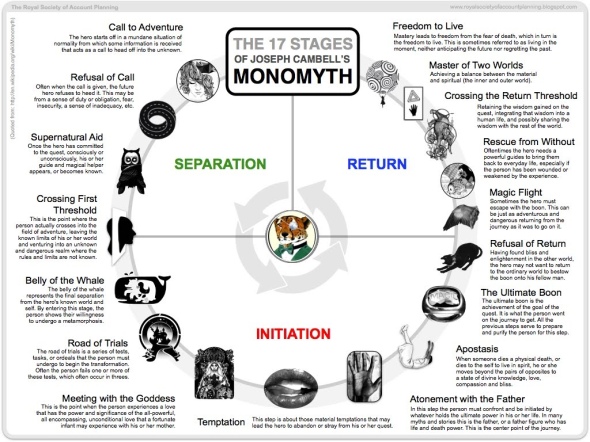The Buddha’s One Noble Truth?
Posted: August 23, 2014 Filed under: Basics, Living in Truthless Truth | Tags: accept, Advaita, Archie J. Bahm, buddha, desire, ego, Eightfold Path, enlightenment, karma, Koan, nirvana, Noble Truths, philosophy, Reincarnation, Samadhi, samsara, soul, suffering, surrender, truth, zen 9 CommentsIn his 1958 classic “The Philosophy of the Buddha” Prof. Archie J. Bahm analyses the most ancient Buddhist scriptures (“Sutta” and “Vinaya Pitakas”) and suggests that during his 40 year career as a teacher the Buddha only taught one single universal Truth: unfullfilled desire causes frustration and the rejection of frustration is the source of suffering. According to Bahm, all other teachings including the “Four Noble Truths” and the “Eightfold Path” must have been later added to the philosophy by “other minds” due to misunderstandings of what the Buddha was trying to convey.
Now, you may ask, what is so hard to understand about the fact that unfulfilled desire causes suffering? By digging into the problem of desire more closely one easily understands why.
If the cause of suffering is unfulfilled desire, the solution to the problem must be to stop desiring. Simple as that. Simple? Not quite. Basically there are two ways of stopping desire: one either gets out of sight of the objects of desire (seclusion) or one tries to beat desire (asceticism). However, neither of these two approaches really work as the Buddha found out for himself during his pre-enlightment spiritual seeking. On the one hand, some basic desires such as food and sex are not extinguishable as long as one is still human. On the other hand, the desire to stop desiring is still a desire, just a more subtle form of it. So, it is impossible to willingly not desire, because that would be a desire! Furthermore one could argue that stop desiring is not even really desirable as desires provide motivation and fulfilled desires provide satisfaction. By creating emotions, desires are life-affirming.
So desire, when not fulfilled, provides frustration. Stopping desire, though, is life-negating and actually impossible. Not so simple, is it? This is were the genius of the Buddha comes in. He discovered the “Middle Way” between desiring and desiring not to desire. Here is how it goes: if we always desired exactly what we are getting, we would always get satisfaction and the sensation of being alive. Or in other words, if we always accepted everything AS IT IS (within and without), which includes the suffering, we would be free from suffering and live in joy.
Hold on, you may say, how can one accept everything without desiring to accept everything? Of course you are right, accepting without desiring to accept is impossible. Whenever you want something, you desire it, and since trying to not want is also a desire, the attempt will cause endless frustration and suffering. It’s like trying to relax a muscle by forcing it to relax. It just won’t work.
Nevertheless, there is a way the get into the “Middle Way”. It’s a paradoxical way, though. Once the desire to get into the “Middle Way” (or any other desired state) is completely broken, one automatically falls into it. Again, because this “break” cannot directly be achieved by will-power, the way “there” is to either completely exhaust the will to get “there” by trying as sincerely and forcefully as possible (remember the Buddha had his sudden enlightenment at the moment of renouncing 7 years of hard-core asceticism!) or by thoroughly realising by other means that the YOU has no power or control over the process of accepting or desiring. The former way is nowadays practised in Zen (e.g. with “koans”), the latter in Advaita (“SELF-realization” aka “there is no YOU”). Both, the exhaustion of the will or “Self-realization”, leads to a surrender to WHAT IS, which paradoxically, yields exactly what one was desiring to get but what one actually prevented from getting by the very desiring (or desiring to not desire) to get it!
Now, to make the long story short, the surrendering to Samsara (the world AS IS) is the way to Nirvana (desiring WHAT IS). Samadhi is the complete willingness to accept the actual as the ideal. The crux, though, is that surrendering cannot be achieved by the individual (“ego”), one has to be pushed into it, as it were, by some sort of grace in the form of will-undermining insight(s).
Finally, why does Prof. Bahm conclude that this is the only Truth that the Buddha taught? First of all, the Buddha was concerned with one thing only: the cessation of suffering. According to the records he stated this very clearly. Then he discovered that the only solution to the problem of suffering lies in surrendering to the present moment (WHAT IS). So, everything that was not concerned with the present moment like concepts of the past (e.g. “karma”) or the future (e.g. “reincarnation”) or any other metaphysical speculation (e.g. the question of the “soul”) he did not deem helpful for solving the problem of suffering. Therefore in the ancient texts the Buddha never answered any questions of that sort. He neither denied nor affirmed these concepts. For the Buddha in the oldest scriptures, the existence or non-existence of metaphysical entities and ideas simply did not change the fact that to end suffering one had to come to surrender to whatever IS in this very moment no matter what the cause or effect of this present moment was. By implication, this also means that as long as one’s ideas lead one to align one’s desires with WHAT IS, any “Truth” would be as good as another.
For the very same reason the Buddha also refrained from stating anything idealistic or from proclaiming any sort of higher virtues (e.g. he never idealised a monastic lifestyle or compassion). Whatever IS is to be surrendered to to end suffering. That is the full story of the teaching in the old texts. All else, including all methods and “Paths”, must have been added later by disciples not fully understanding the full depth of “whatever IS” (on the other hand, though, one could easily conclude, that all Buddhist methods and concepts must have been created to completely frustrate the seeker and/or make him experience his lack of power to get to Nirvana in order to bring him to the very brink of it).
Additional personal note: the old-school philosophy of Buddha portrayed here can be criticised for the lack of moral outrage at the obvious evils like cruelty in the world. If one, for some reason or other, though, cannot surrender to the present-moment because of its monstrosity, and suffers as a result of it, one could still surrender to the non-surrender and the suffering, and therefore transcend the suffering. Hence, accepting “whatever IS” is not fatalistic. One can have an (unfulfillable) desire for a world without cruelty and not suffer, if (s)he can surrender to the frustration of this unfulfilled desire.
This little conundrum also explains the difference between before and after getting into “surrendering-mode”. “Before” one suffers over one’s frustration and because of that one starts suffering over the suffering, and suffering of the suffering over the suffering, etc. Suffering creates a downward spiral, a grip, if not surrendered to. “After” one may be frustrated (because of one’s unfulfilled desire) but one does not suffer over the frustration because the frustration is accepted. The spiral of suffering stops right there.
Furthermore, allthough I think that many of our desires actually stem from our fears and insecurities I see the Buddha’s point in not being concerned with the causes of desire, as the causes could be indefinite. Instead he went right to the immediate solution: accepting whatever IS includes one’s suffering caused by one’s fears. Quite smart the guy…
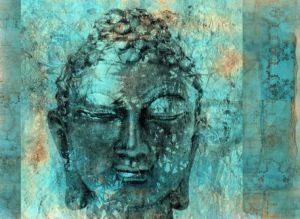
Short Reflections (3): On Life Being “Just” A Dream
Posted: January 7, 2013 Filed under: Pointers | Tags: Advaita, brahman, buddhism, dream, illusion, judgement, movie, nirvana, non-duality, ramana, rilke, samsara, subjectivity, surrender 12 CommentsOnce we start to hang out in spiritual circles of the Buddhist or Advaita kind we soon enough come across statements like “life is an illusion” or “life is just a dream”. While teachings pointing to the “unreality” of the world as we perceive it through the filter of our minds are very helpful, I find spiritual seekers often get stuck in it. And whenever seekers get stuck, it is because they mistake the metaphor for the reference.
All the “dream”-metaphor refers to is the fact that how we perceive the world is fundamentally subjective. The image of the world as we know it is a function of our individual set of conditioned beliefs of good and bad (in time and space). The judgmental (good vs. bad) interpretation of the stream of experiences creates the illusion of an observatory experiencer, an entity separate from the stream. This split is the source of duality: there is a “me” experiencing and evaluating what is happening within and without. Accordingly, non-duality is realizing the “me” as another experience, as another aspect of the stream. It is the awakening to the truth that all there is, is the stream of experience. Thus, by entering the stream, “we”, the subjective “judge” dissolves. And by no longer objecting or trying to control the stream, we flow with it and suffering ends.
Unfortunately, for many people I have met, the metaphor seems to mean that they should suspend judgement or negate their subjective experiences. Both approaches, though, are expressions of a fundamentally judgmental nature. They can’t work, because whenever we do something to get something we are operating from a stance of good vs. bad. “I should not judge” is as judgmental as it gets.
Spiritual pointers and metaphors are not meant to make us do something but simply to acknowledge and accept how it is. Hence, to enter the stream (and dissolve the “judge”) all one has to do is to fully acknowledge our imaginary views of the world. Once we don’t care about judgement anymore, we have transcended judgement, and we enter. When we say “yes” to everything, even to our conditioned “no’s”, unity is restored. Nirvana is Samsara fully embraced.
There are certain ways to bring this state of surrender about. Ramana Maharshi for example would say that the world is unreal (a subjective image), that fundamentally only Brahman (the “raw” stream of experience) was real, but that in the end, the world was Brahman. So, even the subjective judgement (the “me”) is an expression of the sacred, because it is also an experience. There is only experience, unity, and “thou art that”.
The (teaching-)approach which works for me is a bit different, though. I compare living with going to the movies. We all know that the whole fun of going to the movies is to forget that is a movie and to get lost in the plot. So, if we kept telling us it was “just” a movie or “just” an illusion, we could have stayed home, because it negates the whole movie experience. The same applies to life. If we keep telling ourselves that life is “just” a dream, we keep ourselves out of, that is, detached from life (see an older post on detachment). To get the most out of a movie experience one has to get wholeheartedly involved in the plot. Hence, getting completely sucked in by life without wobbling or hesitating, to live for the sake of playing out our part on the world stage, whatever this part turns out to be, that is the enlightened life. It is a sacred “yes”, which is unconditional, which does not expect anything in return and which, for those reasons, will yield constant surprise, wonder and gratefulness. A “dream” it is, but what an amazing one!
“Let everything happen to you. Beauty and terror. Just keep going. No feeling is final.”
~Rainer Maria Rilke
The Trick Of The Trade
Posted: November 11, 2012 Filed under: Pointers | Tags: acceptance, control, double bind, ego, flow, letting go, nisargadatta, now, surrender, zen 1 CommentI have written on this blog much about (self-)acceptance, letting go and surrender to “what is” as the key tenets of spirituality. At the same time I have tried to convey the point that acceptance, letting go and surrender is not something we can do, force or bring about. There is no way we can help ourselves on the path to enlightenment. In fact, the very trying is what makes it completely unfeasible. We have to trick ourselves into it somehow.
Because that is so, any spiritual method, in one way or another, tries to undermine the “ego”, that is, our reflex to control and manipulate our experiencing of “what is”. Therefore, I have tried to show you either that there is no separate “you” (wisdom about life) or that the world exactly as it “is”, the full catastrophe, is perfect (love for life).
This time I will try to synthesize these two positions, the position of (non-dual) wisdom and (dual) devotion. I will do so by trying to prove that the “we” (the “ego”) has no control whatsoever over our experiences and that this is no problem at all. To me, this is the ultimate trick of the spiritual trade.
Let’s start with our five senses. Do we have control over the experience of seeing, touching, hearing, smelling or tasting? No, we don’t. Our senses can’t be shut down (only blocked). Even if we are not conscious of hearing, touching, seeing, smelling or tasting (because we may not pay particular attention), unconsciously the gates of perception are always wide open.
Let’s now consider thoughts. Can we not think of a pink elephant while we are reading this line? No, we can’t. Thoughts constantly arise from the depths of the unconscious. We have no control as to what thoughts arise at what time. Can we stop thoughts? No. Since the “we” is itself a thought, “we” trying not to think thoughts just creates more “we” thoughts (thickening the illusion of a solid “we”). Stopping thoughts is as impossible as licking our own tongue. Try and you’ll notice it will just create motion in your mouth. A thought (the “we”) can never control another thought (it can only replace it).
What about feelings? Feelings are regulated by thoughts which are the mental precursors to physical sensations: when we have “good” thoughts we feel good and when we have “bad” thoughts we feel bad. As stated above, thoughts arise from the unconscious and are uncontrollable. Hence, we have no control over our feelings either.
What all this proves is that just as we cannot be spontaneous on purpose, we cannot influence our sensory perceptions, thoughts and feelings. We cannot want to be spontaneous because both, spontaneous and unspontaneous acts always happen spontaneously, that is, without our implicit consent! Likewise, we cannot want to change our experiences, because they always happen no matter how we feel about them! Think about it.
And it gets even more interesting as we delve deeper into the subject. As we understand that thoughts determine how we feel and that we have no control over our thoughts, the “we” is naturally inclined to try to change how we were conditioned by our parents and society (our “judges”) to interpret our experiences. We know, that if we reject our experiences, we suffer. So, we may think: “Let’s accept it all, “good” or “bad”! Let’s surrender to everything! Let’s go with the flow!” Of course, though, not controlling is as much an “ego”-trip as controlling since any intent to do something about our experience is a total denial of “what is”. Trying to accept and surrender logically implies a stance of non-acceptance and non-surrender. No matter where we turn, there is no way out of this “double bind”. Whatever option we chose, controlling or not controlling, we can only go wrong. “We” are trapped.
At some point (for some after many, many years of struggling!) it will hopefully dawn on us that there is nothing “we” can do: no controlling thoughts and feelings, no “be here now”, no “going with the flow”, no letting go, no surrendering, no (self-)accepting, no (self-)improving, no spiritual method, no absolutely nothing at all that will work to “advance” on the spiritual path and find peace of mind! Of course, having truly realized this IS the ultimate disillusionment, the death of the (imaginary) “ego” that the spiritual path is all about!
To know that nothing can be done to change one’s experiences coupled with the wisdom that the universe, with its interplay of light and dark, is perfect in design leads one directly into the hands of (self-)acceptance and surrender. There is no more grounds for objecting to anything! All is, and has always been, as it was supposed to be! And even if we wanted, it couldn’t be changed anyhow because the “we” is (just another experience and therefore) absolutely powerless. There is no need and no capacity for change, ever.
In reality, all that “is” is this divine “No-thing” experiencing itself through itself. We are the container and the contained. We, the universe, move(s) through ourself. With this realization, the dis-ease with “what is” in this present moment ceases and we leave our futile struggles to find salvation in the future behind. And this is non other than the most natural human condition. Or nothing special, as they would say in Zen.
“Unless you make tremendous efforts, you will not be convinced that effort will take you nowhere. The self is so self-confident that unless it is totally discouraged it will not give up. Mere verbal conviction is not enough. Hard facts alone can show the absolute nothingness of the self-image.”
~Nisargadatta Maharaj
Devoted To The Illusion
Posted: September 20, 2012 Filed under: Living in Truthless Truth | Tags: adyashanti, bodhisattva, eros, maya, nisargadatta maharaj, opposites, ramakrishna, ramana maharshi, samsara, surrender, thanatos 1 CommentIn Indian philosophical schools of thought Maya represents the power of the universe to veil the fundamental unity of things. It is this ignorance about the ‘oneness’ underlying the world of the ‘many’ as we perceive it, which is commonly identified in the East as the cause of all existential suffering. To the great Indian sage Sri Ramakrishna Maya, nonetheless was an object of sincere devotion. He was said to be all love and reverence for it. For him Maya was God.
“Hold on”, you might say, “isn’t Maya the enemy, the darkening illusion we are supposed to dispel by virtue of spiritual discipline under the guidance of a Master or Guru?”
My answer is yes and no. Let me explain.
I would like to define Maya which is often synonymously used as the ignorance about ‘oneness’ or the illusion of duality in different terms than usual. For me Maya is the mistaken belief in the inherent reality of pairs of opposites like good or bad, holy or evil, light and shadow etc.
Whatever we experience through our senses is the interplay of the pairs of opposites. If the world was all white or all black, we couldn’t see. It’s the interplay of black and white and all the colors within the visible spectrum of light between these extremes that make it possible to have visual experiences.
With experiences comes the notion of difference between aspects of the sensory input that make up the experience. In other words, black and white, although they represent but different wavelengths of light, are seen as different, two.
This perceptual duality, in turn, leads to the cultivation of preferences, that is, fear and grasping, aversion and attachment. The tension and attraction that arises out of these mind-states is what motivates all sentient beings to act. This ‘elan vital’ is what keeps the wheel of life (Samsara) turning. Much (if not all of) evolution and progress is owed to this ‘force’. And it is what ultimately causes bliss as well as suffering. In that sense, yes, Maya is the sustainer of this game called life. It is what psychologically binds us tightly to its cycle of creation and decay, birth and death. From that perspective, the perspective of duality, Maya is indeed the enemy.
Therefore, it comes by no surprise that Yogis of some Hindu or Buddhist schools strive to transcend Maya and life’s tensions and attractions altogether. In other words, they are trying to renounce what constitutes life. They want to drop out the game. Thus, their spiritual practices aim at diminishing the will to live (Eros) in favor of the wish for annihilation (Thanatos).
Whenever we strive to transcend or cling to certain aspects of life, however, we are still operating within the realm of opposites, of duality. In that sense, trying to transcend duality exposes one’s dualistic outlook. One can never drop out of the game of life by trying to transcend it, because the very effort is what characterizes the game.
What to do?
To really drop out of the game of constant chasing or hiding from the opposites, we have to drop into it completely. The way out is the way in. This is to say that we have to find a way to accept the rules unconditionally. Because as long as we don’t, we are still playing along. Only in not objecting to anything, we transcend the logic of Samsara which is based on the push-pull forces of opposition and attraction. Just as the only way to stop a train from moving is to jump right on it, the only way to stop life from taking us on its roller coaster is to not interfere but to flow with it. In other words, the only way to drop out of the game of life is to give up completely any attempt whatsoever to abandon or master it. In surrendering to life, we claim our liberation from it.
How to surrender, though?
Maya is only a ‘problem’ as long as we are still enthralled by its hallucinatory spell of duality. Once we see through Maya and realize who we truly are, that is, when we call your own bluff of us and the world being something other than what all else is, we are free. The rules of the game still apply but we lose any objection to them as we know that we are the only player playing our own game with our Self (this ‘One’ that we and everything else fundamentally is). There is nothing that can ever be lost or gained in this game, there are no winners or losers, and there is no particular meaning to it other than to play it. We cannot do anything whatsoever to leave it because we can never separate from it, or transcend it, because in fact, we ARE it. It’s all been a cosmic joke, a hoax, as Alan Watts would say. We alone exist. We will never come nor go anywhere, ever. All there is, is no-thing playing some-thing with itself.
When we realize this, our eyes open wide and we discover that Maya is the most precious gift we could ever have made to our Self. Seen from that perspective, the perspective of unity, Maya is the constant invitation to a deep sense of gratitude and awe. When we realize our Self in everything and everything in our Self, we become the biggest admirer of this apparent ‘many’. Maya, after all, is the tremendous and fascinating expression of our own mysterious divinity. IT is we and we are IT.
To touch this unity is to become a devotee of the multiplicity. Thus, many spiritual masters, such as Nisargadatta Maharaj or Ramana Maharshi, had a deeply devotional side (sometimes to the great confusion of their students caught up in ideas of duality being somehow unreal). Because they are so devoted to their Self in disguise, they see no point in trying to “sell” people their insights. They know that all apparent parts of their Self at any time play their roles in this game perfectly well and with immense dedication and commitment. Their deepest admiration and respect goes out to those who are suffering, and it is in this admiration and respect where compassion has its origin. The sages realize that the game is so exquisitely designed by their Self that it is always in perfect harmony. Pleasure and pain, good or evil, one game, one life. It does what it does.
So, finally, that’s the conundrum of spiritual life: to live truly and wisely means to immerse ourselves into the dualistic world of Maya as if it was a serious matter whilst knowing it is fundamentally not. The Bodhisattva, thus, is somebody who, just for the sake of playing it, sincerely participates in an entirely fictional game. (S)he is like an actor wholeheartedly incarnating a role in an improvised plot while never forgetting that in the end of the day it’s all play. That way (s)he remains grounded in the game while not being rooted in it.
“When someone asks me who they are or what God is, I smile inside and whisper to the Light: There you go again pretending.”
~Adyashanti
The ‘Holy’ Grail
Posted: July 3, 2012 Filed under: Pointers | Tags: atonement, dark night, duality, ego, healing, now, Oneness, self, surrender Leave a commentBefore you read on, close your eyes quickly and ask yourself: what is the most important thing in life?
I bet you did not come up with specific acquisitions or achievements but with something emotional, something related to the quality of your experience, like to love, to live your dreams, to be of service to others, etc. What this little thought-experiment shows is that what we all seem to be striving for in life is not to accumulate ‘things’ or ‘success stories’ but experiences of life. Or in short: the most important thing in life is to be truly alive.
To truly live does not sound to be too hard a thing to accomplish, doesn’t it? The great Oscar Wilde would have disagreed, though, stating that “to live is the rarest thing in the world – most people exist, that is all.” Why is it, then, that although we are striving for more ‘life’ in our lives most of us seem to fail quiet miserably at it and end up merely ‘existing’?
The quest for the elixir of (more) ‘life’ is a recurring mythological theme. In the Grail legend, for example, there is the fisher king who reigns over a kingdom that has degenerated into an infertile wasteland ever since he had gotten a mysterious injury for which there was no cure. Only the legendary Grail was said to be able to heal the king’s wound and thereby restore the kingdom to its splendor of the old days. While the wound in this myth symbolizes the king’s impaired capacity to fully experience life (his kingdom!) in all its greatness, the Grail is that which can bring back the juice into a lifeless existence.
So, what is the ‘holy’ Grail? Where can it be found? In the Grail legend, the knights of the kingdom in demise who are called to find it, all set out in different directions. That is to say, the Grail can be found in many places. If you read my last post about the different ‘Way’s of the Bodhisattva’ you know that I posited that the Grail, whose healing powers are none other than those of the ‘Now’, is present in any self-referencing and self-sufficient activity or symbol since either possesses the capacity to -at least temporarily- cut through the subject/ object duality which otherwise covers the ‘Now’ in a thick cloud of fear and desire.
What the Grail legend with all the ordeals the knights have to go through is also telling us is that to live, to be truly alive, we first need to make sure we are facing our experiences. Although that sounds rather straightforward and easy enough, it actually isn’t. Because non-disalignment with our experience means that we not only ‘flow’ along with ‘pleasurable’ experiences but also with the ‘unpleasurable’ ones. It means saying ‘yes’ to everything. If we repress or hide from ‘unpleasant’ experiences, we become emotionally and experientially numb. Just like in the story of the fisher king, any inability to properly attend to our emotional pain slowly grows into a disability turning our worlds, our kingdoms, into dry wastelands ruled by hidden dragons in our unconscious. The famous motivational speaker Jim Rohn was spot on when he said that “the walls we build around us to keep the sadness out also keep out the joy”.
While the ‘artistic’ knight may use his or her artistic craft to deal with and release emotional pain, the ‘spiritual’ knight, lacking such a craft, heals his- or her psyche by surrendering to and, thereby, accepting all experiences unconditionally. (S)he does so by cultivating non-judgemental awareness to all that ‘is’. This cultivation, sometimes called ‘meditation’, reaches its climax when (s)he identifies with the indiscriminating, unconditionally loving awareness itself or, alternatively, when (s)he has realized that all that ‘is’, even the ‘unpleasant’ experiences are non other than the fundamental reality (emptiness) manifest as relative reality (form).
Surrendering is the process of purification (or purgatory) any ‘spiritual’ knight has to pass through to be eligible for the final, grand at-one-ment. The deeper (s)he dares to surrender, the more deeply buried, repressed emotional pain and trauma is released from the darkness of the unconscious to be subsequently burnt in the light of consciousness. As the difficult ‘healing’ process in this ‘dark night of the soul’ progresses, resistance to the phenomenal world starts to fade, calming the ‘spiritual’ knight’s mind and gradually tearing down the imaginary walls that create the sense of an isolated ‘self’. As a result, the whereabouts of the Grail become more and more intuitively known.
No matter how much the ‘spiritual’ knight surrenders, though, the notion of subject-object will still hold, and as long as this is the case, thought-waves of separation will have a recipient, a shore to crash upon. The ‘spiritual’ knight who wants to get hold of the Grail once and for all and, thereby, become a sage, thus, needs to go one final step further: the notion of a subject surrendering to an object has to let go of. (S)he needs to realize his- or herself to be inseparable of all that ‘is’, of this ‘One’ which encompasses both, ocean and waves, emptiness and form, of ‘That’ which is no-thing because it is every-thing. In this realization the ‘self’, finally known to be illusory, a mirage, ‘dies’ to be resurrected into the ‘spirit’. Henceforth, thought-waves ridden by fear and desire originating from the trance of separation between the individual and its environment, simply fade out in the vastness of the ocean unclaimed. Surrendering then becomes an impossibility, as it is known that there is no-body to surrender to any-thing since there is no-thing apart from every-thing (which of course, and quiet paradoxically, is the most complete form of surrender). In the discovery of the ‘un-reality’ of the self, the ‘holy’ Grail naturally reveals itself as having never been lost, yielding its boon to the ‘spiritual’ knight of being able to peacefully rest in the abundance of the eternal ‘Now’.
“What we are really living for is the experience of life, both the pain and the pleasure.”
~Joseph Campbell

